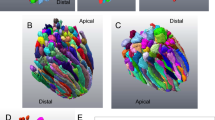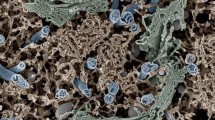Summary
Crab photoreceptors were examined after treatment by the osmium-DMSO-osmium method for high-resolution scanning electron microscopy. This technique of specimen preparation was also adapted for transmission electron microscopy, enabling sections up to 1 urn thick to be viewed in a conventional microscope at 75 kV. With appropriate pretreatment, some cytoskeletal elements can be visualised by both techniques. The methods were then used to investigate some of the daily changes known to occur in photoreceptor cell structure. Striking differences were found in the structure of Golgi bodies present in retinula cells during the synthesis and breakdown phases of the daily cycle of photoreceptor membrane turnover. Cyclic changes were also noticed in the mitochondria of retinula cells, and additional evidence was found for a previously proposed model of rhabdomeral microvillus formation.
Similar content being viewed by others
References
Allen RD, Weiss DG, Hayden JH, Brown DT, Fujiwake H, Simpson M (1985) Gliding movement of and bidirectional organelle transport along single native microtubules from squid axoplasm: evidence for an active role of microtubules in cytoplasmic transport. J Cell Biol 100:1736–1752
Begg DA, Rebhun LI, Hyatt H (1982) Structural organisation of actin in the sea urchin egg cortex: microvillar elongation in the absence of actin filament bundle formation. J Cell Biol 93:24–32
Blest AD (1980) Photoreceptor membrane turnover in arthropods: comparative studies of breakdown processes and their implications. In: The effects of constant light on visual processes Williams TP, Baker BN (eds.) Plenum Press, New York, pp 217–245
Blest AD, de Couet HG, Howard J, Wilcox M, Sigmund C (1984a) The extra-rhabdomeral cytoskeleton in photoreceptors of Diptera. I. Labile components in the cytoplasm. Proc R Soc Lond [Biol] 220:339–352
Blest AD, Stowe S, de Couet HG (1984b) Turnover of photoreceptor membranes in arthropods. Sci Prog (Oxford) 69:83–100
Blest AD, Stowe S, Eddey W (1982) A labile, Ca2+-dependent cytoskeleton in rhabdomeral microvilli of blowflies. Cell Tissue Res 223:553–573
Blest AD, Stowe S, Price DG (1980) The sources of acid hydrolases for photoreceptor membrane degradation in a grapsid crab. Cell Tissue Res 205:229–244
Chambers C, Grey RD (1979) Development of the structural components of the brush border in absorptive cells of the chick intestine. Cell Tissue Res 204:387–405
de Couet HG, Stowe S, Blest AD (1984) Membrane-associated actin in the rhabdomeral microvilli of crayfish photoreceptors. J Cell Biol 98:834–846
Eguchi E, Waterman TH (1967) Changes in retinal fine structure induced in the crab Libinia by light and dark adaptation. Z Zellforsch 79:209–229
Eguchi E, Waterman TH (1976) Freeze-etch and histochemical evidence for cycling in crayfish photoreceptor membrane. Cell Tissue Res 169:419–434
Farquhar MG, Palade GE (1981) The Golgi apparatus (complex) — (1954–1981) — from artifact to center stage. J Cell Biol 91:77s-103s
Fernandez HL, Burton PR, Samson FE (1971) Axoplasmic transport in the crayfish nerve cord. J Cell Biol 51:176–192
Franke WW, Eckert WA, Krien S (1971) Cytomembrane differentiation in a ciliate, Tetrahymena pyriformis I. Endoplasmic reticulum and dictysomal equivalents. Z Zellforsch 119:577–604
Hafner GS, Tokarski T, Hammond-Soltis G (1982) Development of the crayfish retina: a light and electron microscopic study. J Morphol 173:101–118
Harris N. Oparka KJ (1983) Connections between dictysomes, endoplasmic reticulum and GERL in cotyledons of mung bean (Vigna radiata L.). Protoplasma 114:93–102
Inoue T, Inoué TE (1981) Some methods for observing cytoskeleton by scanning electron microscopy. J Clin Electron Microsc 14:5–6
Ip W, Fischman DA (1979) High resolution scanning electron microscopy of isolated and in situ cytoskeletal elements. J Cell Biol 83:249–254
Itaya SK (1976) Rhabdom changes in the shrimp, Palaemonetes. Cell Tissue Res 166:265–273
Maupin-Szamier P, Pollard TD (1978) Actin filament destruction by osmium tetroxide. J Cell Biol 77:837–852
Mizuhira V, Futaesaku Y (1971) On the new approach of tannic acid and digitonine to the biological fixatives. 29th Proc Electron Microsc Soc Am. Arceneaux CJ (ed). pp 494–495, Claitor's Pub Div., Baton Rouge
Morré DJ, Ovtracht (1977) Dynamics of the Golgi apparatus: membrane differentiation and membrane flow. In: Bourne GH, Danielli JF, Jean KW (eds). Int Rev Cytol Suppl 5. Academic Press, pp 61–188
Nässel DR, Waterman TH (1979) massive diurnally modulated photoreceptor membrane turnover in crab light and dark adaptation. J Comp Physiol A 131:205–216
Simionescu N, Simionescu M (1976) Galloylglucoses of low molecular weight as a mordant in electron microscopy. I Procedure and evidence for mordanting effect. J Cell Biol 70:608–621
Stowe S (1980) Rapid synthesis of photoreceptor membrane and assembly of new microvilli in a crab at dusk. Cell Tissue Res 211:419–440
Stowe S (1981) Effects of illumination changes on rhabdom synthesis in a crab. J Comp Physiol 142:19–25
Stowe S (1982) Rhabdom synthesis in isolated eyestalks and retinae of the crab Leptograpsus variegatus. J Comp Physiol 148:313–321
Stowe S (1983) Control of light-induced and spontaneous breakdown of the rhabdoms of a crab at dawn: depolarisation vs calcium levels. J Comp Physiol 153:365–375
Stowe S, de Couet HG Monoclonal antibodies to crayfish rhodopsin II. Turnover of photoreceptor membrane in the crayfish Cherax studied by electron microscopy and anti-rhodopsin immunohistochemistry (in preparation)
Stowe S, Fukudome H, Tanaka K (1984) Three-dimensional membrane configurations in crab photoreceptors studied by high resolution SEM and by thick section TEM at 75 kV. (abs.) Int Cell Biol 1984 Seno S, Okada Y (eds) The Japan Society for Cell Biology, p 277
Tanaka K (1980) Scanning electron microscopy of intracellular structures. Int Rev Cytol 68:97–125
Tanaka K, Iino A (1974) Critical point drying method using dry ice. Stain Technol 49:203–206
Tanaka K, Mitsushima A (1984) A preparation method for observing intracellular structures by scanning electron microscopy. J Microsc 133:213–222
Tanaka K, Naguro T (1981) High resolution scanning electron microscopy of cell organelles by a new specimen preparation method. Biomed Res [Suppl] 2:63–70
Toh Y, Waterman TH (1982) Diurnal changes in compound eye fine structure in the blue crab Callinectes. I. Differences between noon and midnight retinas on an LD 11:13 cycle. J Ultrastr Res 78:40–59
Tsui H-CT, Ris H, Klein WL (1983) Ultrastructural networks in growth cones and neurites of cultured central nervous system neurons. Proc Natl Acad Sci USA 80:5779–5783
Warren RH (1984) Axonal microtubules of crayfish and spiny lobster nerve cords are decorated with a heat-stable protein of high molecular weight. J Cell Sci 71:1–15
Waterman TH (1982) Fine structure and turnover of photoreceptor membranes. In: Westfall JA (ed) Visual cells in evolution. Raven Press New York, pp 23–41
Waterman TH, Piekos WB (1983) Nocturnal rhabdom cycling and retinal hemocyte functions in crayfish (Procambarus) compound eyes. II. Transmission electron microscopy and acid phosphatase localisation. J Exp Zool 225:219–231
White RH (1967) The effect of light and light deprivation upon the ultrastructure of the larval mosquito eye. II. The rhabdom. J Exp Zool 166:405–426
White RH (1968) The effect of light and light deprivation upon the ultrastructure of the larval mosquito eye. III. Multivesicular bodies and protein uptake. J Exp Zool 169:261–278
Author information
Authors and Affiliations
Rights and permissions
About this article
Cite this article
Stowe, S., Fukudome, H. & Tanaka, K. Membrane turnover in crab photoreceptors studied by high-resolution scanning electron microscopy and by a new technique of thick-section transmission electron microscopy. Cell Tissue Res. 245, 51–60 (1986). https://doi.org/10.1007/BF00218086
Accepted:
Issue Date:
DOI: https://doi.org/10.1007/BF00218086




